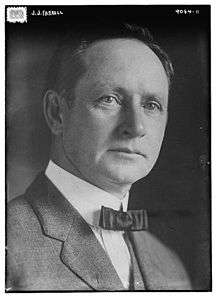John J. Farrell
John J. Farrell (1872 - July 22, 1946) was the Dairy and Food Commissioner of Minnesota in 1917 and president of the National Creamery Buttermakers' Association. By 1921 he was the secretary of National Dairy Products.[1] He was the unsuccessful Democratic candidate in the United States Senate elections of 1924 for senator from Minnesota.[2] He was the Minnesota Democratic state chair in 1931.[3]

Biography
He was born in 1872 in Ohio to Daniel Farrell and Mary Guyton, both Irish immigrant parents. They migrated to Minnesota in 1886. He married in August 1901 Mabel Sanborn of Faribault, Minnesota, a daughter of W. N. Sanborn.[1]
By 1917 he was the Dairy and Food Commissioner of Minnesota and president of the National Creamery Buttermakers' Association.[2]
By 1921 he was the secretary of National Dairy Products Committee.[4] In 1924, he was the unsuccessful Democratic candidate for U.S. Senator from Minnesota.[3]
He died on July 22, 1946 in South Harbor Township, Mille Lacs County, Minnesota.
Footnotes
- "John J. Farrell". Compendium of History and Biography of Carver and Hennepin Counties, Minnesota.
- "John J. Farrell". Sunday Oregonian. January 14, 1917. Retrieved 2015-01-09.
- "John J. Farrell". Political Graveyard. Retrieved 2015-01-09.
- "John J. Farrell, Secretary of the National Dairy Products Committee". Butter Cheese and Egg Journal. 1921. Retrieved 2015-01-09.
| Party political offices | ||
|---|---|---|
| Preceded by James A. Carley |
Democratic nominee for U.S. Senator from Minnesota (Class 2) 1924 |
Succeeded by Einar Hoidale |